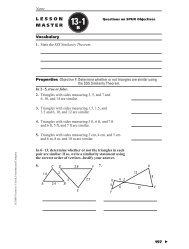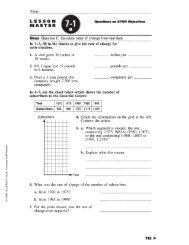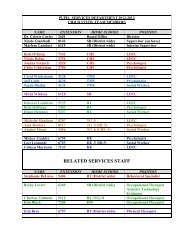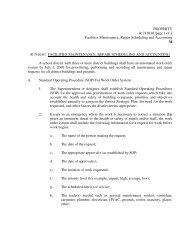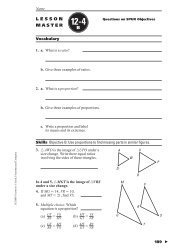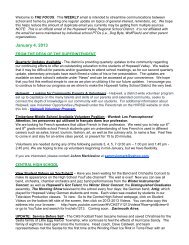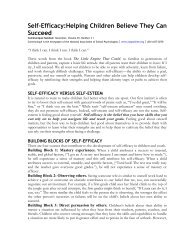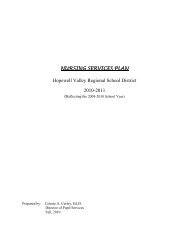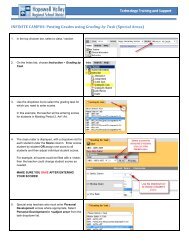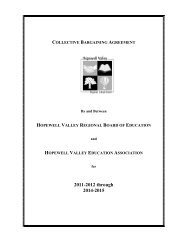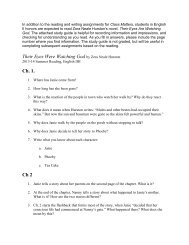ValleyView200712Winter - Hopewell Valley Regional School District
ValleyView200712Winter - Hopewell Valley Regional School District
ValleyView200712Winter - Hopewell Valley Regional School District
You also want an ePaper? Increase the reach of your titles
YUMPU automatically turns print PDFs into web optimized ePapers that Google loves.
6<br />
THE VALLEY VIEW W INTER 2007<br />
Gyms, Fields No Longer Free<br />
U<br />
sers of district-owned gymnasiums and fields began<br />
paying rent for the first time in January, as district<br />
officials continue to explore non-tax revenue sources<br />
to help support the school system’s budget.<br />
Beginning Jan. 1, non-profit organizations using<br />
the district’s fields, gymnasiums, tennis courts and classrooms are<br />
paying hourly rates ranging from $10 to $50, depending on the<br />
day.The highest rates will be charged on Sunday, when the cost<br />
of renting a gym, classroom or parking lot, reaches $50 an hour.<br />
Field rental is $15 per hour, regardless of the day of the week.<br />
Fees cover the cost of custodial service, utilities and normal<br />
wear and tear. Until now, the district has historically secured<br />
nothing more than proof of insurance from users of its facilities.<br />
In January the Board approved a grant agreement with the<br />
<strong>Hopewell</strong> Basketball League, locking in the rental rate for league<br />
members in exchange for lump-sum payments dedicated for facility<br />
upgrades. Under the agreement, the gymnasium at Bear<br />
Tavern Elementary <strong>School</strong> will get an air-conditioning system.<br />
The league will pay $30,000 for the first 1,000 hours and regular<br />
rates, which range between $25 and $50, after that. ■<br />
Timberlane 8th graders Jeff Mulford, Madison Schreiber and<br />
Kari Lang (left to right) get an aerobic workout in DDR during a<br />
recent wellness class.<br />
If You Can’t Beat ‘Em …<br />
I<br />
f flexibility is in the toolkit of the effective teacher, then<br />
chalk another one up for the wellness teachers at<br />
Timberlane Middle <strong>School</strong>.<br />
Dance Dance Revolution, a popular and interactive<br />
computer game that challenges players to match rhythm<br />
and choreography while following onscreen arrows for dance steps,<br />
is part of the cardioaerobic options available to students in wellness<br />
classes.<br />
Wellness teacher Candace Gore, who first saw the game last spring<br />
in a boardwalk arcade, helped pitch it as an addition to the curriculum,<br />
noting its obvious cardio benefits, not to mention its high fun factor.<br />
“Any time you can show them activity is fun, they’re going to<br />
want to continue it,” says Gore.“Our goal is to get students to participate<br />
in daily physical activity voluntarily.There’s a ton of data out<br />
there that shows the participation of young girls, in particular,<br />
declines big-time once they get to high school.”<br />
Set to a soundtrack with a wide selection of contemporary dance<br />
music, DDR plays on a regular TV monitor and players go through<br />
their steps on a specially marked foam floor pad. Pads are connected<br />
to a PlayStation console.Timberlane has two interactive pads, allowing<br />
two students to play at a time, and another dozen non-interactive<br />
pads, allowing 14 students in all to follow along.<br />
Although DDR is offered as an optional activity, at the same<br />
time as ping pong, Gore says the pads are never empty long enough<br />
to get cold.“The kids love it.”<br />
For teachers like Gore, who believe that the seeds for physical<br />
activity in adulthood are planted in childhood and are best nurtured<br />
when they result in voluntary exercise, DDR is a perfect fit in the<br />
curriculum.<br />
“Gone are the days that you put them in line and march them<br />
around a gym,” says Gore.“It may be good for them, but so is castor<br />
oil.” ■<br />
Everybody is Doing It (Cont. from page 1)<br />
Perkins says perceptions are shaped by three influences – culture<br />
(entertainment,advertising,news,and the media),social psychology (we<br />
are drawn to remember and repeat stories of extreme,weird events) and<br />
psychology (we interpret and make sense of things based on our understanding<br />
of the context of the situation.)<br />
Vice principal Kat D’Ambra, who is coordinating the project in<br />
<strong>Hopewell</strong> <strong>Valley</strong>, says it is important for parents and educators to challenge<br />
the “everybody is doing it” attitude by training youth to ask<br />
themselves the right questions.<br />
❖ How do you know that<br />
❖ Can you explain the context of the story<br />
❖ What were other people doing<br />
❖ Do you believe this story represents what everyone does/believes to be<br />
acceptable<br />
❖ What do you think about the behavior<br />
“We rarely hear stories about the young people who don’t engage<br />
in risky behaviors,” says D’Ambra.“The stories we do hear are of the<br />
extreme behaviors and usually with limited contextual understanding,<br />
but they are the stories that create misperception about the attitudes and<br />
behaviors of the majority of students. This is the creation of the everybody-is-doing-it<br />
myth upon which young people are norming their<br />
own behaviors.<br />
“We need to debunk the mythology.”<br />
Data collection for the norming project at CHS began in<br />
November, when 651 students were surveyed on their attitudes about<br />
tobacco, alcohol and drugs.At 53% of the student body, the size of the<br />
sampling easily qualified as representative. By contrast,TV’s Nielsen ratings,<br />
which influence billions of dollars of advertising spending, are collected<br />
on nearly 10,000 of the nation’s 105.5 million households.<br />
Using the survey results, a student-designed, multi-media marketing<br />
campaign, will be launched in the next month.The first target is<br />
parents.<br />
“This is about how to have an intelligent, respectful conversation<br />
with young people about how they make choices,” said D’Ambra. ■




